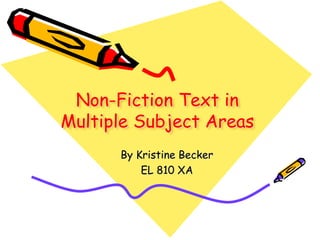
Inquiry #4
- 1. Non-Fiction Text in Multiple Subject Areas By Kristine Becker EL 810 XA
- 2. Reading Curriculum Reading Comprehension Phonics & Phonemic Awareness Vocabulary Fluency Text Features Compare and contrast Sequencing Story Elements Inference Research and Inquiry
- 3. Non-Fiction Text & Math Read a book about an informational topic and make calculations or measurements. Read about the Titanic and find the perimeter and area of the first, second, and third class suites. Read about earthquakes and measure the distance of land that the earthquake effected. There are many books to read during math. Find books by Cindy Neuschwander and Wayne Geehan or Brian P. Cleary and Brian Gable.
- 4. Non-Fictions Text & Social Studies Students can learn about economics, history, geography and civics through text. History: Students can read a book, journal, or diary about a pioneer moving west. Economics: Students could read a book about supply and demand and create their own business. Geography: Read about different places around the world and look at maps. Civics: Read about the branches of government and create a class government. Student’s prior knowledge and background can cause difficulties because students may not have experienced many of the events from history, such as the underground railroad.
- 5. Non-Fiction Text & Science “If you plan to do an investigation with worms and you read about worms first, the initial wonder is gone. Let students observe and touch and handle worms before reading about them, Winokur advises. The hands-on experience will not only help students understand scientific words and concepts, but will give them a reason to turn to the text” (Fink, L. W. Jennifer. 2012-2013). Use interactive text on Discovery Education or National Geographic Science has many vocabulary words to incorporate in reading and lessons Connect to current events and real-world situations with NASA or Scholastic News
- 6. “As with any structure or strategy, you will need to explicitly model how you as an expert reader use a text feature to make a prediction. This is best done using a think- aloud in a whole-group setting” (Kelley, M. J. and Clausen-Grace, N, 2010). All Images from Power point Clip Art